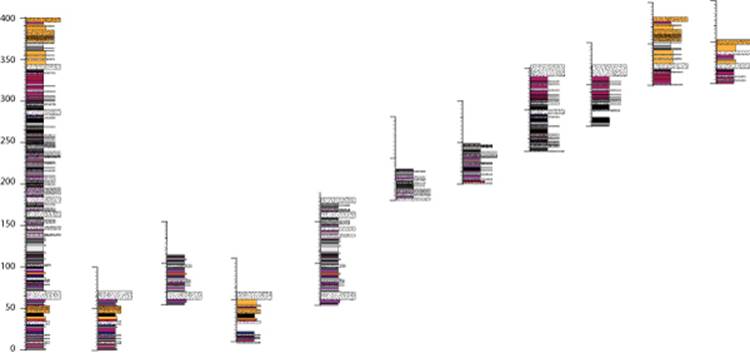Reports: ND252222-ND2: Linking Coastal Terrestrial Ecosystems and Eustatic Sea-Level Changes: A Case Study in the Tornillo Group (Big Bend National Park, TX)
Gabriel Bowen, University of Utah
During project year two our group has conducted a wide range of geochemical, petrographic, and field analyses that have allowed us to develop a well constrained chronostratigraphic and paleoenvironmental record spanning most of the Paleocene in Big Bend National Park (BBNP). Key scientific results from this new record include demonstration that the Black Peaks Formation in the eastern part of BBNP preserves a nearly continuous ~10 million year record of climate- and possibly sea-level-driven changes in subtropical terrestrial deposition, more precise stratigraphic correlation of Paleocene and Eocene short-term climatic and environmental change events within the Formation, and new data illustrating significant, multi-million-year trends in soil wetness that are strongly correlated with global carbon cycle and climate change and may reflect changes in tropical and/or mid-latitude monsoonal atmospheric circulation. Significant project activities have included:
1) Field work. Six students (PhD student Clement Bataille, MS student Dylana Watford, undergraduates Stephen Ruegg and Alex Lowe, and technicians Amy Steimke and Galen Gorski) and the PI conducted 7 days of field work in BBNP in March, 2014 (Fig. 1). Primary emphases include measuring and sampling new sections to fill gaps in and extend the composite section developed in our previous field work, field checking correlations among sections, and collecting additional material from previously sampled sections for new analytical work. As a result of our efforts we have developed a continuous master section for the Early Paleogene Black Peaks Formation in the Tornillo Flats area of BBNP, with a total thickness of almost 400 meters (Fig. 2).
Figure 1 – Panorama of Black Peaks Fm. outcrops, Tornillo Flats, BBNP.
2) Carbonate isotope geochemistry. Undergraduate researcher Stephen Ruegg and graduate students Clement Bataille and Dylana Watford have led our efforts to develop a composite chemostratigraphic section for the Black Peaks Fm. Stable C and O isotope ratio data have been generated from several hundred samples collected throughout the composite section. Bataille has been leading the integration of these data with previously published bio and magnetostratigraphic data to develop a chronostratigraphic framework for the Formation; this work will be described in a manuscript currently in preparation. Watford and Ruegg have been generating additional data to complement the isotope record, including petrographic and physical descriptions of nodules collected throughout the sections, elemental data (see below), and pilot clumped isotope data (in progress with collaborator Kate Huntington, Univ. of Washington).
3) Elemental geochemistry. Watford and undergraduate researcher Alex Lowe have been leading work to develop major element records from Black Peaks Fm. paleosols and pedogenic carbonate nodules. These will be used to estimate changes in soil weathering and paleo-precipitation (via the CIA-K weathering index) and constrain variation in conditions of paleosol carbonate nodule formation throughout the study section. Paleosol analyses are complete for the lower ~250 m of the composite section, and nodule geochemistry has been measured throughout the section.
Figure 2 – Composite lithostratigraphic section for the Black Peaks Fm. on Tornillo Flats, BBNP (left), based on synthesis of data from 10 local sections measured during the course of our project.
4) Professional and career development. We have been able to provide a range of valuable training and advancement opportunities. The supported work has advanced the PI’s research portfolio in a new direction, focusing his efforts on Paleocene climate change and terrestrial carbon cycling. This led to the development of a collaborative proposal submitted to NSF in spring, 2013 and several new projects investigating terrestrial carbon cycle change during the Early Paleogene. PhD student Bataille has been engaged in the project in a supervisorial role, and has gained substantial experience mentoring the undergraduates on the project team as they collectively plan and execute field and lab work, interpret data, and prepare presentations and proposals. He defended his PhD dissertation in June, 2014, is currently completing a manuscript on the Black Peaks Fm. chronostratigraphic framework, and will start a position with Chevron’s research group this fall. The project will form the core of MS student Dylana Watford’s thesis, and she has been engaged in field work and learned several new laboratory methods through her work on the project. This coming winter she will travel to a collaborator’s lab to learn and make clumped isotope measurements of our samples. Two undergraduates have been closely engaged in the project and exposed to new field geology and laboratory experience. One (Ruegg) graduates with his BS this fall and is about to submit a senior honors thesis on his project work. A second (Lowe) will graduate within the next ~year and will likely also pursue a thesis. Ruegg, Bataille, and Watford have/will all presented components of our work at national meetings, and all of the students involved have made presentations at local university or department events.













